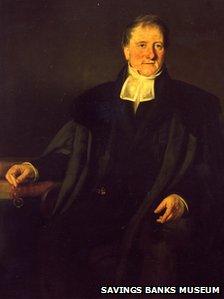Newly independent TSB owes its origins to Dumfriesshire
- Published

Rev Duncan founded what is claimed to be the world's first savings bank
The Trustees' Savings Bank (TSB) has regained its independence as a standalone brand, 18 years after it merged with Lloyd's.
The move has been welcomed in a tiny hamlet in Dumfriesshire to which the TSB traced its origins in 1810. BBC Scotland's Social Affairs Correspondent Reevel Alderson has been investigating.
It all began when the Rev Henry Duncan, minister of Ruthwell, opened what is claimed to be the world's first savings bank.
It was based on business principles, paying interest on its investors' modest savings.
At the time commercial banks required a minimum deposit of £10 to open an account, a sum well out of the reach of agricultural labourers who earned 10d (4p) a day.
His original parish bank in Ruthwell is now the Savings Banks Museum., external
Museum assistant Mhairi Hastings said it was highly necessary to help the casual workforce of the early 19th Century.
'Zero-hours contracts'
"There was a real demand because farm workers couldn't open bank accounts, as they didn't earn enough," she said.
"There was almost a culture of zero-hours contracts, because they were only paid for the days they worked - and they received payment once every three months.
"The bank enabled them to budget until their next wages were paid."
The 18th Century building housing the museum receives about 1,000 visitors a year, and is just one of three in the UK devoted to banking.

The 18th Century building which houses the Savings Banks Museum attracts about 1,000 visitors a year
The others are in London, at the Bank of England, and in Edinburgh at the Bank of Scotland.
The savings bank movement flourished throughout the UK with a large number of local organisations until they were brought together in the 1970s.
This was followed by a stock exchange flotation in 1986 and the creation of TSB Group.
That move was fiercely contested by the Scottish National Party (SNP) which opposed what it saw as "privatisation".
Who actually owned the bank which was being floated was unresolved and something of a legal minefield, a matter ultimately tested in law by a retired civil servant, Jim Ross.
The organisation merged with Lloyds Bank in 1995 to form Lloyds TSB, the bank which has now been split up.
One local bank remains - the 178-year-old Airdrie Savings Bank - which has eight branches.
In 2011 the bank, which has no shareholders and reinvests surpluses for the benefit of customers, opened its first outside of Lanarkshire - in Falkirk.
The bank's chief executive, Rod Ashley, said: "Since it was founded the bank has witnessed periods of challenge including the double-dip recession.
"Face-to-face customer service and the 'community bank ethos' is key to the approach we've taken to the business.
"It is because of this that we have been able to grow amidst a challenging economic climate to retain customers and extend our offering to lending and general banking services for business customers."
The idea developed by Rev Duncan spread even further, and by 2002 there were 109 savings banks organisations in 92 countries.